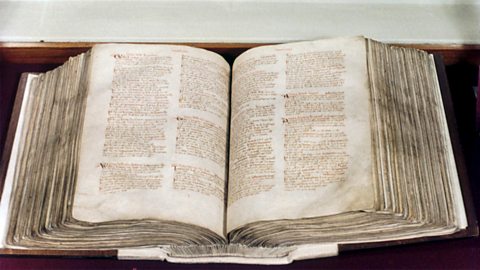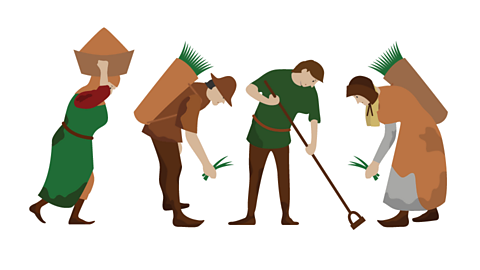Key points
- When William conquered England, he had a limited knowledge of peopleâs wealth and property in the country.
- He was concerned about potential invasions and attacks from enemies, and needed to raise money to fund an army.
- He needed to find out who owned land, and how much wealth every person had, so he could tax them accordingly and raise the necessary funds.
- To do this, he sent out his supporters to survey the country. This detailed record of England was called the Domesday Book. It gives historians a great source of information to find out what life in medieval England was really like.
Why did William need the Domesday Book?
After establishing control in England with the Harrying of the NorthA campaign by William to crush opposition in the north of England. The impact was devastating. The Domesday Book shows it led to the population decreasing by 75%. and the building of castles, William had secured his position as king. But in 1085 he was concerned that England was under threat from a Viking invasion. To defend his land, he needed a large army. This would be expensive, so William needed to know who he could tax and how much people could afford to pay. To do this, he needed to surveyExamining and investigating to find out information about people or land. the land and people of England. The Domesday Book also includes information about a small number of places in Wales, which were very close to the border with England. It doesn't include any information about Scottish landowners, as William did not control Scotland.
Video about the Domesday Book
Narrator: How successful Williamâs conquest of England had been was revealed in a survey, conducted in 1086.
With the constant threat of rebellion, he needed to know how much tax he could raise to fund an army. Norman commissioners held public inquests in towns and villages right across England. They questioned who held the land now, and who had owned it in 1066. They wanted to know everything, from how many freemen and slaves there were, to how many ploughs and pigs.
The English people called it the Domesday Book, the day of judgment. It revealed William possessed about 20% of the wealth of England, his barons 50%, and the Church had 25%. The surviving English nobles had a meagre 5%.
The Anglo-Saxons had been totally overpowered. William had conquered, and secured the power of England, and the Normans had completely taken over.
How was the information gathered?
William sent his men to find out detailed information about the value of land and resources in England. They split the country up into different regions based on existing county borders. Technically, as William owned all land, everyone else in England was a tenant. Landowners had to send in details of their land and who lived and worked on it. commissionerSomeone appointed to a job to find out information about something. Domesday commissioners were appointed by William to find out about land and resource value in England. were then sent in to question the landowners and check the details. The survey aimed to find out:
- Who owned the land and how much was it worth?
- How many people lived on the land?
- How much woodland was on the land?
- How many animals were on the land?
- What buildings were on the land?
- How much were the land and goods worth in 1066, when William took over?
- How much were the land and goods worth in 1086, at the time of the survey?
All of this information was then pulled together as a record of wealth and land ownership for the whole country. It was written in Latin and the first version was completed by August 1086. There were two volumes of DomesdayDomesday means âjudgment day.â This shows the importance of the information in the book to William. The decisions in the book were final and couldnât be disputed.: Little Domesday and Great Domesday. Little Domesday covered Essex, Norfolk and Suffolk in great detail. Great Domesday covered the rest of the country and was likely completed by a single scribeSomeone who writes down information for someone else..
What does the Domesday Book tell us?
The completed book is an extremely detailed record of life in England in medieval times. It contains over 13,000 records of places across England, as well as a small amount of information about places in Wales, just over the border. The Domesday Book shows that:
- William directly controlled about 20% of the land
- Norman nobilityMembers of the ruling class, just below the king in the feudal system. controlled about 50% of the land (which was ultimately owned by William)
- The Church controlled about 25% of the land
- English nobility controlled about 5% of the land
This meant that a huge amount of the land was controlled by a small number of powerful people. It also showed that the Normans had overpowered the Anglo-Saxons, as only 5% of land was controlled by English noblemen.
Is the Domesday Book a complete record of life in England in 1086?
The Domesday Book is an excellent source of information and shows what life was like in England after the Norman conquest. It details land ownership, jobs, what animals people owned and what laws were in place.
But there is a lot it doesnât cover, and so it cannot be seen as a complete record. The Domesday Book does not list every person who lived in the country, as William was mainly interested in wealthy landowners who he could tax to fund his army. A consequence of this is that women and poor people are underrepresented in the survey, as most landowners were wealthy men.
Also, the Domesday Book does not list every single location in the country. For example, Winchester and London, two of the largest cities in England at the time, as well as areas of the north east in Northumbria and Durham, are not included. William was still establishing full control of these areas.
Consequences of the Domesday Book
The Domesday Book was finished in 1086, a year before Williamâs death. The detailed records made it possible for taxes to be raised and these helped William and future medieval monarchs administerTo be in charge of running something. and rule the country. The total value of land listed in the Domesday Book is around ÂŁ73,000. From this, William was earning income of around ÂŁ22,500 per year. In todayâs money, William is calculated as being one of the ten richest men of all time.
The Domesday Book was the most detailed account of life in England, until the first national censusA national survey that counts the population of a country. was carried out in England in 1801.
The Domesday Book is an incredibly useful primary sourceA piece of evidence from the time an event took place. and it provides a lot of information about what life was like in England after the Norman Conquest. For example:
- It lists 45 vineyards, suggesting a large amount of wine was produced in England.
- It shows how many Normans had moved to England to look after land for William. Land that was owned by about 2000 Saxons in 1066 was now controlled by 200 Normans.
- It shows that a lot of buildings had been destroyed by Williamâs invasion in 1066.
- It includes local laws that give an impression of how society worked. For example, there are two references in entries from Kent about landowners having to provide bodyguards for the king. There is also mention of cartage, which was a requirement to provide the local sheriffSomeone appointed to oversee law and order in a county. with an ox and sometimes a cart. Both of these suggest the law was enforced.
The original copy of the Domesday Book is still held at the National Archives in London. Individual records from the book can be searched online, helping local historians find out more about the history of where they live.

Test your knowledge
Play the History Detectives game! gamePlay the History Detectives game!
Analyse and evaluate evidence to uncover some of historyâs burning questions in this game.

More on William's control of England
Find out more by working through a topic
- count1 of 3

- count2 of 3
